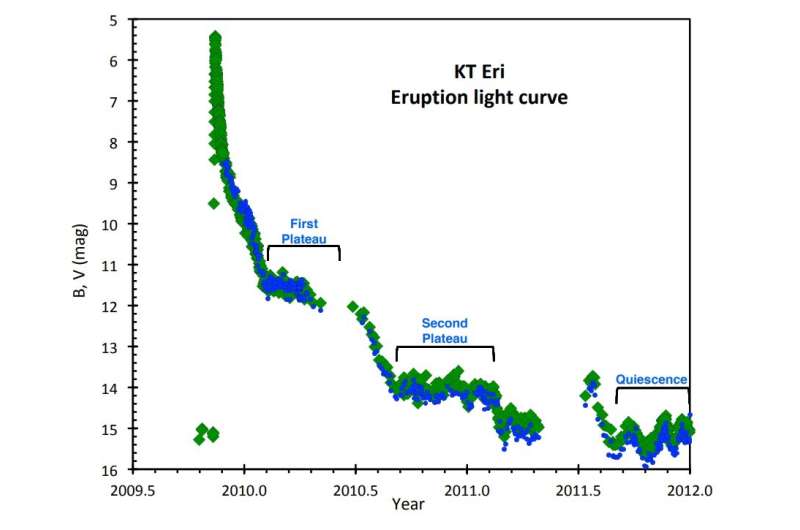October 27, 2022 report
KT Eridani is a recurrent nova, study finds

By analyzing a large set of photometric data, astronomers have investigated KT Eridani—a nova detected in 2009. The study, published October 19 on arXiv.org, found that KT Eridani is a recurrent nova with a recurrence time-scale of 40–50 years, and delivered crucial information regarding the fundamental parameters of this source.
A nova is a star experiencing a sudden increase in brightness and slowly returning to its original state, a process that could last many months. Such an outburst is the result of the accretion process in a close binary system containing a white dwarf and its companion.
Recurrent novae (RNe) are cataclysmic variables (CVs) consisting of a white dwarf accreting material from a companion star, and that have undergone more than one nova eruption. They have much shorter recurrence time (below 100 years) when compared to the classical novae (CNe), which likely recur with a timescale of up to 100,000 years.
KT Eridani (or KT Eri for short) was a bright and very fast nova in the constellation Eridanus discovered on November 25, 2009, ten days after its optical maximum (peaking near 5.42 mag). It faded from its peak brightness by 3.0 mag in about 13 days. Still very little is known about this system and previous studies have suggested that it may be a recurrent nova.
To further investigate this hypothesis, a team of astronomers led by Bradley E. Schaefer of the Louisiana State University, has combed through photometric data collected by various telescopes and astronomical surveys, including NASA's Transiting Exoplanet Survey Satellite (TESS).
"We marshal large data sets of photometry to finally work out the nature of KT Eri," the researchers wrote in the paper.
The study found that KT Eri has an orbital period of approximately 2.61 days and is located some 16,600 light years away. The companion star has evolved off the main sequence and is now a subgiant star with a radius of about 3.7 solar radii and a temperature of 6,200 K. The white dwarf has a mass of around 1.25 solar masses.
The researchers analyzed archival photographs of KT Eri and no eruptions were found from 1928 to 1954 or after 1969. In order to find out whether or not KT Eri is a recurrent nova, the team tried to determine if it exhibited thermonuclear nova eruptions with a recurrence time shorter than 100 years. Previously, the only way to prove that was to spot two or more nova events from the same system, however, many sources with only one observed eruption may actually be RNe for which all of the other eruptions in the century have been missed.
Therefore, they proposed a new method for recognizing RNe that uses the mass of the white dwarf and the mass accretion rate.
"This new method has the strength that it can be applied to most nova systems. And there is no need to wait for a century and hope that the next eruption is not missed," the astronomers explained.
Given that the companion star is losing mass through its inner Roche lobe at a very high rate of approximately 3.5×10−7 solar masses per year, the authors of the study calculated that the recurrence time of KT Eri is 12 years, although with a possible range from 5–50 years. Further analysis of archival data allowed the team to estimate that the most likely range is 40–50 years, confirming that KT Eri is indeed a recurrent nova—only the eleventh such system so far discovered in our galaxy.
More information: Bradley E. Schaefer, Frederick M. Walter, Rebekah Hounsell, Yael Hillman, The Nova KT Eri Is a Recurrent Nova With a Recurrence Time-Scale of 40-50 Years. arXiv:2210.10448v1 [astro-ph.SR], arxiv.org/abs/2210.10448
© 2022 Science X Network



















